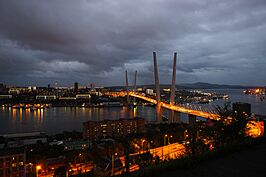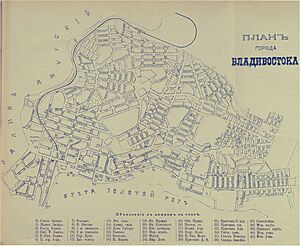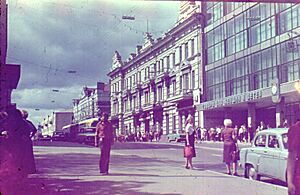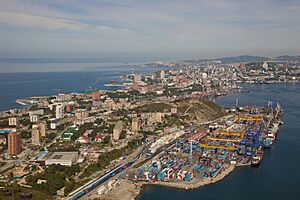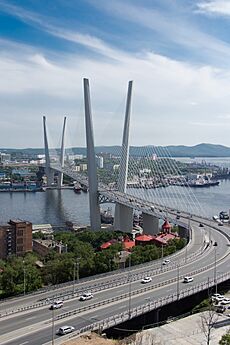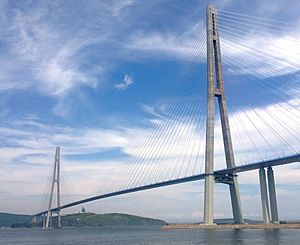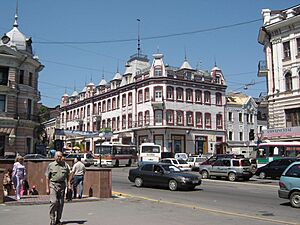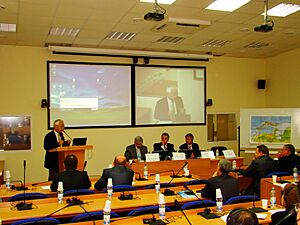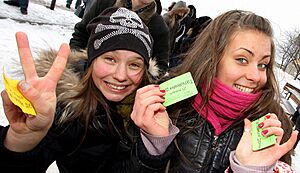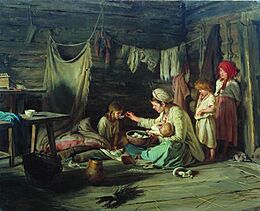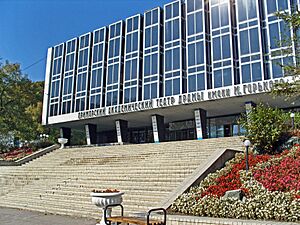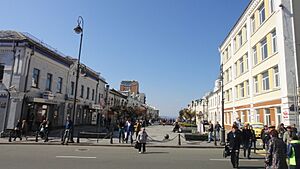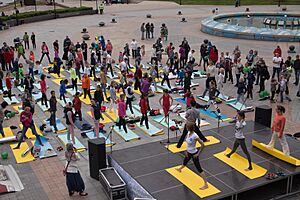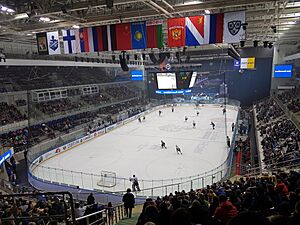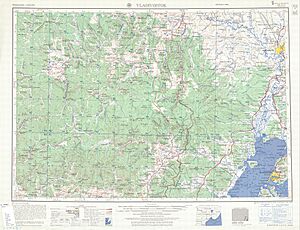Vladivostok facts for kids
Quick facts for kids Vladivostok (English)Владивосток (Russian) |
|
|---|---|
| - City - | |
| [[File:
|250px]] Top-down, left-to-right: View of Zolotoy Bridge and the Golden Horn Bay at night, with the Russky Bridge in the distance; GUM Department Store; Vladimir K. Arseniev Museum of Far East History; the campus of Far Eastern Federal University; Vladivostok Railway Station; and Central Square |
|
|
|
|
| City Day | First Sunday of July |
| Administrative status | |
| Country | Russia |
| Federal subject | Primorsky Krai |
| Administratively subordinated to | Vladivostok City Under Krai Jurisdiction |
| Municipal status | |
| Urban okrug | Vladivostoksky Urban Okrug |
| Head | Konstantin Shestakov |
| Representative body | City Duma |
| Statistics | |
| Area | 331.16 km2 (127.86 sq mi) |
| Time zone | VLAT (UTC+11:00) |
| Founded | July 2, 1860 |
| City status since | April 22, 1880 |
| Postal code(s) | 690xxx |
| Dialing code(s) | +7 423 |
| Official website: http://www.vlc.ru | |
Vladivostok is a major city in Russia. It is the largest city and the main center of Primorsky Krai. It is also the capital of the Far Eastern Federal District. The city is located on the Sea of Japan around the Golden Horn Bay. It covers an area of 331.16 square kilometers (127.86 sq mi). In 2021, its population was 603,519 people.
Vladivostok is the second-largest city in the Far Eastern Federal District. It is also the second-largest city in the Russian Far East, after Khabarovsk. The city is about 45 kilometers (28 mi) from the China–Russia border. It is also 134 kilometers (83 mi) from the North Korea–Russia border.
The city was founded as a Russian military outpost on July 2, 1860. This happened after the Treaty of Aigun and the Convention of Peking were signed. In 1872, the main Russian naval base in the Pacific Ocean moved to Vladivostok. This helped the city grow quickly. By 1914, its population was over 100,000 people. Many different groups of people lived there, including large Asian communities.
After the Russian Revolution in 1917, different forces occupied Vladivostok. These included White Russian and Allied forces. Japanese troops were the last to leave in 1922. The Red Army then took control of the city. After the dissolution of the Soviet Union in 1991, Vladivostok became part of the Russian Federation.
Today, Vladivostok is Russia's largest port on the Pacific Ocean. It is also the main cultural, economic, scientific, and tourism center of the Russian Far East. It is the end point of the famous Trans-Siberian Railway. In 2017, over three million tourists visited the city. Vladivostok is home to the main office of the Pacific Fleet of the Russian Navy. Because of its location in Asia and its Russian architecture, some call it "Europe in the Far East."
Contents
- What Does the Name Vladivostok Mean?
- A Brief History of Vladivostok
- How the City is Organized
- Who Lives in Vladivostok?
- What is the Economy Like?
- Getting Around Vladivostok
- Learning and Education
- News and Media
- Culture and Arts
- Parks and Green Spaces
- Sports and Activities
- City Environment and Pollution
- Where is Vladivostok Located?
- Partner Cities
- Famous People from Vladivostok
- Images for kids
- See also
What Does the Name Vladivostok Mean?
The name Vladivostok means 'Lord of the East' or 'Ruler of the East'. It comes from two Slavic words. Vlad means 'to rule' and vostok means 'east'. Sometimes, people in Russia use a shorter name, Vladik.
The city was first given its modern name in 1859. This was done by Nikolay Muravyov-Amursky. The name first referred to the bay. Later, in 1860, it was used for the new settlement. The name is similar to Vladikavkaz, which means "Ruler of the Caucasus."
Chinese maps from the Yuan dynasty (1271–1368) called Vladivostok Yongmingcheng. This means "City of Eternal Light." Later, during the Qing dynasty, it was known as Haishenwai. This name means "sea cucumber bay" or "small seaside fishing village." Today, China officially calls it Fúlādíwòsītuōkè. However, the old name Hǎishēnwǎi is still used often.
The Japanese name for the city is Urajiosutoku. In the past, it was shortened to Urajio.
A Brief History of Vladivostok
The area where Vladivostok is located had a Chinese settlement around 600 AD. It was called Yongmingcheng.
For a long time, Russia wanted a strong base in the Far East. Many places were tried, but none were perfect. In the mid-1800s, Russia gained new land from China. This happened after the Aigun Treaty and the Convention of Peking. On July 2, 1860, a military ship called "Mandzhur" arrived. It brought soldiers to set up a military post. This post was officially named Vladivostok.
How Vladivostok Grew
The first civilian settler, Yakov Lazarevich Semyonov, arrived in Vladivostok in 1861. In 1870, he became the first head of the post. This marked the start of local self-government. In 1871, Vladivostok became the main naval base for Russia in the Far East. The government encouraged people to move to the area. By 1878, the population was 4,163.
In 1880, Vladivostok officially became a city. It also developed as a naval base to protect against attacks. The 1890s saw a big increase in population and economy. This was due to the completion of the Trans-Siberian Railway. By 1897, about 29,000 people lived in Vladivostok. Ten years later, this number had tripled.
The early 1900s were difficult for the city. Wars and political problems slowed its growth. But after 1907, Vladivostok became important again. It was made the main Russian port on the Pacific Ocean. A "free port" system was introduced. This helped the city grow rapidly until 1914. It became a major economic center. Its population grew to over 100,000. Many different ethnic groups lived there, including large Asian communities.
World War I and the Russian Civil War
During World War I, Vladivostok was not a battle zone. But it was important for bringing in military supplies. These supplies came from allied countries.
After the October Revolution in 1917, the Bolsheviks took power. In 1918, during the Russian Civil War, Allied forces occupied Vladivostok. These included troops from Japan, the United States, and China. They left by 1922. The Red Army then took control of the city. In November 1922, Vladivostok became part of Soviet Russia.
The Soviet Era
After the Soviet power was established, Vladivostok faced challenges. The city's economy was struggling. Many people left, and the population dropped to 106,000. Between 1923 and 1925, a plan helped the city recover. The commercial port became very profitable.
In the 1930s and 1940s, Vladivostok was a transit point for prisoners. These prisoners were sent to labor camps.
During World War II, Vladivostok was not directly attacked. But it was always under threat from Japan. The city played a key role in receiving imported goods. These goods were vital for the war effort.
In 1952, Vladivostok became a "closed city." This meant foreigners were not allowed to visit. This was because it was an important naval base.
In the 1950s and 1960s, the city received special attention. Nikita Khrushchev, the Soviet leader, visited twice. He decided to speed up the city's development. New tram lines and trolleybuses were built. Many new homes and public buildings were constructed.
In 1974, Gerald Ford, the US President, visited Vladivostok. He met with Leonid Brezhnev, the Soviet leader. This was the first time a US President visited the city.
On January 1, 1992, Vladivostok officially became an open city again. This ended its status as a closed city.
Modern Vladivostok
In 2012, Vladivostok hosted the 24th APEC summit. This was a big meeting of leaders from countries around the Pacific Ocean. For the summit, the city's infrastructure was greatly improved. Two huge cable-stayed bridges were built. These were the Zolotoy Rog bridge and the Russky Island Bridge. The Russky Island Bridge is the longest cable-stayed bridge in the world. A new campus for Far Eastern Federal University was also built on Russky Island.
In December 2018, Vladivostok became the administrative center of the Far Eastern Federal District.
In November 2020, the city experienced a rare freezing rain storm. This caused ice up to 1.2 cm thick to cover wires and trees. Many homes lost electricity and heating. A large part of Vladivostok's forests were damaged.
How the City is Organized
Vladivostok is the main administrative center of its region, called the Primorsky Krai. It is divided into five administrative districts:
- Leninsky
- Pervomaisky
- Pervorechensky
- Sovietsky
- Frunzensky
Who Lives in Vladivostok?
The population of Vladivostok has changed a lot over time. Many people from Europe and Asia have moved there. From the late 1890s to the early 1920s, about half of the city's population was Asian. The largest Asian groups were Chinese, Koreans, and Japanese.
The old Chinese quarter was called Millionka. At its busiest, it had up to 50,000 Chinese residents. This area had its own shops and theaters. The city's economy relied heavily on Chinese merchants. There was also a Korean area called Sinhanch'on. Many Koreans moved there after Japan took over Korea in 1910. By 1915, about 10,000 Koreans lived in the city. Sinhanch'on became a center for the Korean independence movement.
Later, these areas were closed down, and their residents were moved. Today, most of the city's population is Russian. However, there are still smaller groups of Koreans and Chinese. There are also recent immigrants from Central Asia, especially from Uzbekistan.
According to the 2010 Russian census, Vladivostok has people from over seventy different groups. The largest groups (over 1,000 people) include:
- Russians (92.4%)
- Ukrainians (2.0%)
- Uzbeks (1.4%)
- Koreans (0.8%)
- Chinese (0.5%)
- Tatars (0.5%)
- Belarusians (0.3%)
- Armenians (0.3%)
- Azerbaijanis (0.2%)
What is the Economy Like?
The main industries in Vladivostok are shipping, commercial fishing, and the naval base. Fishing makes up almost 80% of the city's commercial production. Other food production accounts for 11%.
Importing Japanese cars is also very important for the city's economy. This business employs many people, including salespeople, repairmen, and shipping workers. Vladivostok dealers sell about 250,000 cars each year. Most of these cars go to other parts of Russia.
Recently, the Russian government has tried to improve its own car industry. This has made it harder for car import businesses in Vladivostok. To help, a car factory was moved from Moscow to Vladivostok in 2009. This factory now employs about 700 local people.
Vladivostok as a Seaport
Vladivostok is a key link between the Trans-Siberian Railway and the Pacific Sea routes. This makes it a very important port for cargo and passengers. It handles many types of goods for both local and international trade. In 2018, the port handled 21.2 million tons of cargo.
In 2015, the total value of trade through the seaport was over 11.8 billion dollars. The city traded with 104 different countries.
Tourism in Vladivostok
Vladivostok is in the far southeast of the Russian Far East. It is close to many Asia-Pacific countries. Its unique European culture makes it an interesting place for tourists. The city is part of a project to develop tourism in the Far East called "Eastern Ring." New cultural places like a branch of the Mariinsky Theater have opened. There are also plans for branches of famous museums like the Hermitage Museum.
Vladivostok is considered one of the top Russian cities for tourism. It also has a resort area on the coast of Amur Bay. This area has over 11 health resorts. The city also has a growing gambling zone. The first casino, Tigre de Cristal, was visited by over 80,000 tourists in less than a year.
In 2017, about 3 million tourists visited Vladivostok. This included 640,000 foreigners, mostly from China, South Korea, and Japan. Many people also visit for business trips, like exhibitions and conferences. Vladivostok also has 18 foreign consulates, which brings diplomatic visitors. The city has 46 hotels with 2561 rooms. Most travel companies in the region are located in Vladivostok.
Getting Around Vladivostok
The Trans-Siberian Railway connects European Russia to Vladivostok. This railway, finished in 1905, made Vladivostok Russia's most important Pacific Ocean port. Today, Vladivostok is the main starting point for the Trans-Siberian part of the Eurasian Land Bridge.
Vladivostok is also the main air travel hub in the Russian Far East. Vladivostok International Airport (VVO) is the home base for Aurora airline. The airport was greatly improved in 2013. It has a new 3,500-meter (11,483 ft) runway. A new terminal was built in 2012, which can handle 3.5 million passengers each year.
International flights connect Vladivostok with Japan, China, Philippines, North Korea, South Korea, and Vietnam. You can also fly to Vladivostok from many larger cities in Russia.
Vladivostok is the starting point of the Ussuri Highway (M60). This highway goes to Khabarovsk. It is the easternmost part of the Trans-Siberian Highway, which goes all the way to Moscow and Saint Petersburg. Other main highways go east to Nakhodka and south to Khasan.
City Transportation
Vladivostok's first tram line started on June 28, 1908. Today, public transportation includes trolleybuses, buses, trams, trains, a funicular, and ferryboats.
In 2012, Vladivostok hosted the 24th APEC Summit. For this event, the city's transportation was greatly improved. Two large cable-stayed bridges were built: the Zolotoy Rog Bridge and the Russky Bridge. The Russky Bridge is the longest cable-stayed bridge in the world.
Learning and Education
Vladivostok has 114 general education schools. In 2015, about 50,700 students attended these schools. The city's education system includes preschools, primary schools, high schools, and special schools. It also has centers for extra education.
The city has two gymnasiums and two lyceums. There are also 13 schools that focus on specific subjects. Three Vladivostok schools are among the top 500 schools in Russia. The city also has school competitions and scholarships for students who achieve great things.
In 2016, new branches of the Academy of Russian Ballet and the Nakhimov Naval School opened.
Many colleges and universities offer higher education in Vladivostok. The first higher education institution was the Oriental Institute. Today, the largest university is the Far Eastern Federal University. Over 41,000 students study there, and 5,000 people work there. This university produces a large share of scientific research in the Far East.
Other universities in the city include:
- Vladivostok State University of Economics and Service
- Vladivostok State Medical University
- Maritime State University
- Far Eastern State Institute of Arts
- Far Eastern State Technical Fisheries University
- Pacific Higher Naval School and Pacific State Medical University
News and Media
Over fifty newspapers are published in Vladivostok. The largest newspaper in the Primorsky Krai is Vladivostok News. It had a circulation of 124,000 copies in 1996. Its English-language version is also called Vladivostok News. These newspapers cover local, regional, and international news. The newspaper Zolotoy Rog (Golden Horn) focuses on economic news. Novosti (News) newspaper is popular among young people and covers entertainment and culture.
Many online news agencies operate in Vladivostok. These include NewsVL.ru, Primamedia, Primorye24, and Vesti-Primorye. From 2012 to 2017, there was a youth online magazine called Vladivostok-3000.
As of 2020, there are nineteen radio stations in the city. Three of these are local stations that broadcast 24 hours a day. Radio VBC plays classic and modern rock music. Radio Lemma broadcasts news and various Russian and international songs. Vladivostok FM plays local news and popular music.
Culture and Arts
Art Galleries and Showrooms
Art museums in Vladivostok began to grow in the 1950s. In 1960, the House of Artists was built. It had exhibition halls. In 1965, the Primorsky State Art Gallery became a separate institution. A Children's Art Gallery was later created from its collection.
In 1989, the "Artetage" contemporary art gallery opened. In 1995, the Arka gallery of contemporary art opened. It shows works from international exhibitions. More recently, centers for contemporary art like "Salt" and "Zarya" have become active.
Music, Opera, and Ballet
Vladivostok is home to the Vladivostok Pops Orchestra.
The Russian rock band Mumiy Troll is from Vladivostok. They often perform there. In September 1996, the city hosted the "VladiROCKstok" International Music Festival. This festival attracted nearly 10,000 people.
Today, there is another annual music festival called Vladivostok Rocks International Music Festival and Conference (V-ROX). This three-day festival helps new artists and producers gain exposure.
Musical theater is represented by the Primorsky Regional Philharmonic Society. This organization has the Pacific Symphony Orchestra and the Governor's Brass Orchestra. In 2013, the Primorsky Opera and Ballet Theater opened. In 2016, it became a branch of the Mariinsky Theater.
Museums to Explore
The Vladimir K. Arseniev Museum of Far East History opened in 1890. It is the main museum of Primorsky Krai. Besides its main building, it has three other locations in Vladivostok. These include Arsenyev's Memorial House. The museum's collection includes the famous 15th-century Yongning Temple Steles.
Movie Theaters
In 2014, Vladivostok had 21 movie theaters. They showed films 1,501,000 times.
Most of the city's movie theaters are renovated buildings from the Soviet era. The "Ocean" movie theater has the largest screen in the Far East. It is 22 by 10 meters (72 by 33 ft). The "Ocean" and "Ussuri" movie theaters host the annual international film festival "Pacific Meridians." Since December 2014, the "Ocean" movie theater also has an IMAX 3D screen.
Theaters for Live Shows
The Maxim Gorky Academic Theater was founded in 1931. It hosts drama, musical, and children's theater performances.
The city has five professional theaters. In 2014, 369,800 people visited them. The Primorsky Regional Academic Drama Theater named after Maxim Gorky is the oldest state theater in Vladivostok. It opened on November 3, 1932.
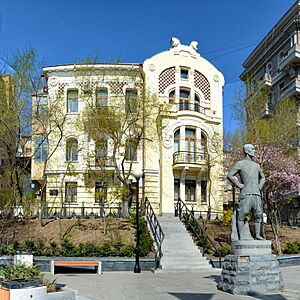
The Primorsky Pushkin Theater was built in 1907–1908. It is now a major cultural center. Other theaters opened later, like the Drama Theater of the Pacific Fleet and the Primorsky Regional Puppet Theater. The puppet theater performed 484 shows in 2015. Over 52,000 people attended these shows. The theater has 500 puppets and 15 artists. They often tour in Europe and Asia.
In September 2012, a granite statue of the actor Yul Brynner (1920–1985) was unveiled. It stands in Yul Brynner Park, in front of his birthplace.
Parks and Green Spaces
Vladivostok has many parks and squares. Some of these include Pokrovskiy Park, Minnyy Gorodok, Detskiy Razvlekatelnyy Park, Park of Sergeya Lazo, Admiralskiy Skver, and Nagornyy Park.
Pokrovskiy Park
Pokrovskiy Park used to be a cemetery. It was changed into a park in 1934. In 1990, it was closed, and the land was given to the Russian Orthodox Church. Graves were found during the rebuilding of the church.
Minny Gorodok
Minny Gorodok is a 91-acre public park. Its name means "Mine Borough Park." It was once a military base founded in 1880. The base stored mines underground. It was turned into a park in 1985. The park has several lakes, ponds, and an ice-skating rink.
Detsky Razvlekatelny Park
Detsky Razvlekatelny Park is a children's amusement park. It is located near Downtown Vladivostok. The park has a carousel, games, a Ferris wheel, cafes, an aquarium, a movie theater, and a stadium.
Admiralsky Skver
Admiralsky Skver is a famous landmark near Downtown Vladivostok. It is an open area with the Triumfalnaya Arka. South of the square is a museum about the Soviet submarine S-56.
Sports and Activities
Vladivostok has a football (soccer) club called Dynamo Vladivostok. They play in the Russian Second Division. The city also has an ice hockey club, Admiral Vladivostok. They are part of the Kontinental Hockey League. The basketball club is Spartak Primorye, which plays in the Russian Basketball Super League. The city also has the Vostok Vladivostok motorcycle speedway club.
Vladivostok hosts various sports contests every year. In 2022, the 35th Regatta boat race and the 19th Russian Championship of Conrad-25R yachts were held there.
City Environment and Pollution
Local environmental experts from the Ecocenter organization say that many of Vladivostok's suburbs are polluted. They believe living in these areas can be a health hazard. Pollution comes from several sources. Vladivostok has about eighty industrial sites. These include shipbuilding and repair, power stations, and fur farming. These industries can be harmful to the environment.
Vladivostok's geography also makes pollution worse. Winds cannot easily clear pollution from some crowded areas. This is because these areas sit in basins. Also, there is little snow in winter, and not much grass or leaves to catch dust.
Where is Vladivostok Located?
The city is located at the southern tip of the Muravyov-Amursky Peninsula. This peninsula is about 30 kilometers (19 mi) long and 12 kilometers (7.5 mi) wide.
The highest point in the city is Mount Kholodilnik, which is 257 meters (843 ft) tall. Eagle's Nest Hill is often called the highest point in the city center. It is 199 meters (653 ft) or 214 meters (702 ft) high.
Vladivostok is in the far southeast of the Russian Far East. It is also in the far southeast of North Asia. Geographically, Vladivostok is closer to Anchorage, Alaska, US, and even Darwin, Australia, than it is to Russia's capital, Moscow. It is also closer to Honolulu, Hawaii, US, than to the city of Sochi in Southern Russia.
What is the Climate Like?
Vladivostok has a humid continental climate. This means it has warm, humid, and rainy summers. Its winters are cold and dry. Because of the Siberian High, winters are much colder than expected for its location. The average temperature in January is -11.9°C (10.6°F). Winter temperatures are colder than in many other cities at similar latitudes.
In winter, temperatures can drop below -20°C (-4°F). But sometimes, mild weather can bring daytime temperatures above freezing. Snow is common in winter, but it usually falls lightly. The maximum snow depth in January is only 5 cm (2 in). Winter days are often clear and sunny.
Summers are warm, humid, and rainy. This is due to the East Asian monsoon. August is the warmest month, with an average temperature of +20°C (68°F). Most of Vladivostok's rain falls during the summer. Cloudy days are common, and humidity is high, around 90% from June to August.
During summer, the city can experience typhoons and tropical storms. Typhoon Sanba hit the city as a tropical storm in 2012. These storms can cause flooding and damage. Typhoons are rare, but tropical storms can happen after a typhoon hits South Korea or Japan.
On average, Vladivostok gets 840 mm (33 in) of rain and snow each year. The driest year was 1943, with 418 mm (16 in) of precipitation. The wettest was 1974, with 1272 mm (50 in). The winter months are dry, and sometimes have no measurable precipitation at all. Temperatures have ranged from -31.4°C (-24.5°F) in January 1931 to +33.6°C (92.5°F) in July 1939.
| Month | Jan | Feb | Mar | Apr | May | Jun | Jul | Aug | Sep | Oct | Nov | Dec | Year |
|---|---|---|---|---|---|---|---|---|---|---|---|---|---|
| Record high °C (°F) | 5.0 (41.0) |
9.9 (49.8) |
19.4 (66.9) |
27.7 (81.9) |
29.5 (85.1) |
31.8 (89.2) |
33.6 (92.5) |
32.6 (90.7) |
30.0 (86.0) |
23.7 (74.7) |
17.5 (63.5) |
9.4 (48.9) |
33.6 (92.5) |
| Mean daily maximum °C (°F) | −7.8 (18.0) |
−3.8 (25.2) |
2.7 (36.9) |
10.1 (50.2) |
14.9 (58.8) |
17.9 (64.2) |
21.6 (70.9) |
23.3 (73.9) |
20.1 (68.2) |
13.2 (55.8) |
3.3 (37.9) |
−5.4 (22.3) |
9.2 (48.6) |
| Daily mean °C (°F) | −11.9 (10.6) |
−8.1 (17.4) |
−1.5 (29.3) |
5.3 (41.5) |
10.0 (50.0) |
13.8 (56.8) |
18.1 (64.6) |
20.0 (68.0) |
16.3 (61.3) |
9.2 (48.6) |
−0.7 (30.7) |
−9.2 (15.4) |
5.1 (41.2) |
| Mean daily minimum °C (°F) | −15.0 (5.0) |
−11.3 (11.7) |
−4.5 (23.9) |
2.1 (35.8) |
7.0 (44.6) |
11.3 (52.3) |
16.1 (61.0) |
17.9 (64.2) |
13.5 (56.3) |
6.2 (43.2) |
−3.5 (25.7) |
−12.0 (10.4) |
2.3 (36.1) |
| Record low °C (°F) | −31.4 (−24.5) |
−28.9 (−20.0) |
−21.3 (−6.3) |
−7.8 (18.0) |
−0.8 (30.6) |
3.7 (38.7) |
8.7 (47.7) |
10.1 (50.2) |
1.3 (34.3) |
−9.7 (14.5) |
−20.0 (−4.0) |
−28.1 (−18.6) |
−31.4 (−24.5) |
| Average precipitation mm (inches) | 12 (0.5) |
16 (0.6) |
27 (1.1) |
43 (1.7) |
97 (3.8) |
105 (4.1) |
159 (6.3) |
176 (6.9) |
103 (4.1) |
67 (2.6) |
36 (1.4) |
19 (0.7) |
860 (33.9) |
| Average extreme snow depth cm (inches) | 5 (2.0) |
4 (1.6) |
3 (1.2) |
0 (0) |
0 (0) |
0 (0) |
0 (0) |
0 (0) |
0 (0) |
0 (0) |
1 (0.4) |
3 (1.2) |
5 (2.0) |
| Average rainy days | 0.3 | 0.3 | 4 | 13 | 20 | 22 | 22 | 19 | 14 | 12 | 5 | 1 | 133 |
| Average snowy days | 7 | 8 | 11 | 4 | 0.3 | 0 | 0 | 0 | 0 | 1 | 7 | 9 | 47 |
| Average relative humidity (%) | 58 | 57 | 60 | 67 | 76 | 87 | 92 | 87 | 77 | 65 | 60 | 60 | 71 |
| Mean monthly sunshine hours | 178.2 | 180.8 | 209.6 | 182.3 | 170.3 | 131.1 | 120.3 | 150.2 | 198.0 | 194.6 | 160.0 | 150.3 | 2,025.7 |
| Source 1: Погода и Климат | |||||||||||||
| Source 2: NOAA | |||||||||||||
| Sea temperature data for Vladivostok | |||||||||||||
|---|---|---|---|---|---|---|---|---|---|---|---|---|---|
| Month | Jan | Feb | Mar | Apr | May | Jun | Jul | Aug | Sep | Oct | Nov | Dec | Year |
| Average sea temperature °C (°F) | -1.2 (29.8) |
-1.6 (29.1) |
-0.9 (30.4) |
2.6 (36.7) |
8.8 (47.8) |
14.2 (57.6) |
19.4 (66.9) |
22.4 (72.3) |
19.4 (66.9) |
13.7 (56.7) |
6.2 (43.2) |
0.7 (33.3) |
8.64 (47.6) |
| Source: | |||||||||||||
Partner Cities
Vladivostok has many partner cities around the world:
 Akita, Japan
Akita, Japan Busan, South Korea
Busan, South Korea Dalian, China
Dalian, China Hakodate, Japan
Hakodate, Japan Harbin, China
Harbin, China Ho Chi Minh City, Vietnam
Ho Chi Minh City, Vietnam Incheon, South Korea
Incheon, South Korea Juneau, United States
Juneau, United States Kota Kinabalu, Malaysia
Kota Kinabalu, Malaysia Manta, Ecuador
Manta, Ecuador Niigata, Japan
Niigata, Japan Pohang, South Korea
Pohang, South Korea San Diego, United States
San Diego, United States Tacoma, United States
Tacoma, United States Tskhinvali, South Ossetia
Tskhinvali, South Ossetia Vladikavkaz, Russia
Vladikavkaz, Russia Wonsan, North Korea
Wonsan, North Korea Yanbian, China
Yanbian, China
In 2010, arches with the names of these partner cities were placed in a park in Vladivostok.
A ferry from Vladivostok travels regularly to Donghae, South Korea. From there, it goes to Sakaiminato in Japan.
Famous People from Vladivostok
- Alexandra Biriukova (1895–1967), architect
- Alexei Volkonski (born 1978), canoeist
- Anna Shchetinina (1908–1999), captain
- Diana Ankudinova (born May 31, 2003), singer
- Elmar Lohk (1901–1963), architect
- Feliks Gromov (1937–2021), admiral
- Igor Ansoff (1918–2002), mathematician
- Igor Kunitsyn (born 1981), tennis player
- Igor Tamm (1895–1971), physicist
- Ilya Lagutenko (born 1968), singer
- Ivan Vasiliev (born 1989), ballet dancer
- Kristina Rihanoff (born 1977), dancer
- Ksenia Kahnovich (born 1987), model
- Lilia Akhaimova (born 1997), gymnast
- Mary Losseff (1907–1972), singer, film actor
- Mikhail Koklyaev (born 1978), strongman
- Natalia Pogonina (born 1985), chess player
- Nikolay Dubinin (1907–1998), biologist
- Peter A. Boodberg (1903–1972), scholar, linguist
- Stanislav Petrov (1939–2017), soldier, averted nuclear war
- Svoy (born 1980), musician
- Swathi Reddy (born 1987), Indian actress
- Victor Zotov (1908–1977), botanist
- Vitali Kravtsov (born 1999), ice hockey forward
- Vladimir Arsenyev (1872–1930), explorer
- Vladimir Ossipoff (1907–1998), architect
- Wes Hurley (born 1981), filmmaker
- Yul Brynner (1920–1985), film actor
Images for kids
-
American troops marching on Vladivostok following the Allied intervention in the Russian Civil War, 1918
See also
 In Spanish: Vladivostok para niños
In Spanish: Vladivostok para niños


